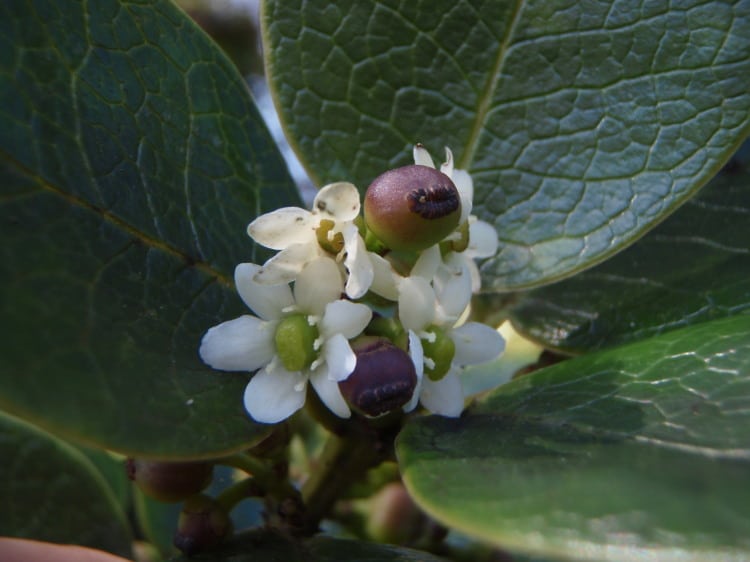Ilex anomala, also known as Hawaiian Holly is a native Hawaiian shrub or small tree with cultural and ecological significance. Found throughout Oahu, it thrives in forests, gardens, and landscaped areas. The plant is known for its glossy, dark green leaves and small, white, clustered flowers. It blends seamlessly into local environments and supports native wildlife.
The foliage offers year-round color, while the flowers attract beneficial insects and birds. This makes Ilex anomala, or Hawaiian Holly ideal for gardeners seeking natural beauty and biodiversity. Its slow growth and compact size suit both residential and public spaces. Once established, the plant requires minimal care or water.
This holly species adapts to various elevations and soil types, including wet and mesic forests. It grows best in partially shaded areas with well-drained soil. On Oahu, it remains a staple in restoration projects and native plant gardens. People value it for its ease of maintenance and resilience.
By choosing Ilex anomala, or Hawaiian Holly, gardeners promote Hawaii’s native plant heritage. They also support local wildlife and conserve ecological balance. Learning about Ilex anomala, or Hawaiian Holly fosters sustainable gardening practices. It is more than a plant, it is a symbol of Hawaiian conservation.
Ilex anomala – Hawaiian Holly Details
Ilex anomala, or Hawaiian Holly, belongs to the Aquifoliaceae family and is one of the few hollies native to Hawaii. It grows as a shrub or small tree, often reaching heights of 10 to 30 feet. The plant features leathery, elliptical leaves and inconspicuous white flowers that bloom throughout the year. Small black drupes follow the blooms and serve as a food source for native birds.
This species naturally occurs in mesic to wet forest zones, typically from 1,000 to 5,000 feet elevation. Its presence contributes to healthy forest canopies and promotes biodiversity in Oahu’s unique ecosystems. Ilex anomala, or Hawaiian Holly is also wind-tolerant and moderately drought-resistant once mature. These traits make it a hardy and adaptable landscape choice.
The bark is smooth and gray, while the wood is dense and resistant to decay. Native Hawaiians historically used the plant’s wood for tools and other functional objects. Its ecological and cultural roots make it valuable in modern conservation landscaping. Whether in a natural preserve or backyard, it brings beauty and function together.
In both urban and forested settings, Ilex anomala, or Hawaiian Holly enhances the environment. Its physical characteristics and native range define its landscaping appeal. With Ilex anomala, or Hawaiian Holly, every garden supports ecological restoration.
Varieties and Cultivars
Unlike other holly species, Ilex anomala, or Hawaiian Holly has limited recognized varieties or cultivars due to its endemic nature. It is primarily found in the wild or used in native Hawaiian landscaping without significant genetic modification. While there are no widely marketed cultivars, some plants show variation in height, leaf shape, and growth habits. These subtle differences often reflect local growing conditions across Oahu.
Growers occasionally select specimens for specific traits like compact size or dense foliage. These traits suit smaller garden spaces or urban installations needing native species. Although not officially named cultivars, these selections still retain the essence of Ilex anomala, or Hawaiian Holly. Such adaptations promote diversity while maintaining the plant’s ecological identity.
Because the plant remains largely unchanged, gardeners can expect consistent performance across similar environments. This consistency is especially beneficial in restoration and conservation projects. The lack of hybridization also helps protect Hawaii’s natural plant gene pool. Maintaining genetic purity ensures resilience and ecological balance.
Despite the absence of formal cultivars, Ilex anomala, or Hawaiian Holly remains versatile and desirable. It adapts beautifully to many garden styles and functions. Choosing Ilex anomala, or Hawaiian Holly supports both cultural heritage and landscape sustainability.

Best Time to Plant
The ideal time to plant Ilex anomala, or Hawaiian Holly is during Oahu’s wet season, from November through March. During these months, the soil retains moisture, helping young roots establish quickly and effectively. Rainfall also reduces the need for supplemental watering, making early growth more sustainable. Starting in this period sets the plant up for success in the drier months ahead.
Cooler temperatures during the wet season prevent heat stress, which benefits tender new roots. The consistent rainfall also encourages steady top growth and deeper root development. For Oahu residents, this aligns perfectly with natural weather cycles and seasonal garden planning. By planting at the right time, you avoid common issues like drought shock.
If planting during the dry season, ensure regular irrigation and mulching to retain soil moisture. However, even under these conditions, Ilex anomala, or Hawaiian Holly can adapt with proper care. The plant’s natural resilience allows for some flexibility in timing. Still, optimal conditions make establishment faster and easier.
Planning ahead can make a big difference in plant health and growth. Choose the wet season for a smoother gardening experience. With Ilex anomala, or Hawaiian Holly, timing ensures thriving, not just surviving.
Growing Conditions
Ilex anomala, or Hawaiian Holly thrives in well-drained, slightly acidic soils rich in organic matter. On Oahu, it naturally grows in mesic and wet forest environments, making moisture an essential factor. While it tolerates partial sun, it prefers dappled light or partial shade for optimal development. Too much direct sunlight can scorch leaves and hinder growth.
Humidity and consistent rainfall help the plant flourish, especially in early stages of development. Once mature, it becomes more drought-tolerant but still benefits from occasional deep watering. Ilex anomala, or Hawaiian Holly also tolerates wind and varying elevations across Oahu’s diverse landscapes. Its adaptability makes it a reliable option for native plant gardens.
The plant grows best in zones free from frequent frost or extreme temperature shifts. On Oahu, the climate is ideal year-round, supporting healthy leaf growth and steady flowering. Mulching helps regulate soil temperature and retain moisture during drier months. With proper conditions, this holly can thrive with little intervention.
Understanding its needs helps create a sustainable, long-lasting garden. Choose the right spot with moisture, light, and soil considered. Ilex anomala, or Hawaiian Holly rewards careful placement with beauty and resilience.
Planting Instructions
Planting Ilex anomala, or Hawaiian Holly successfully starts with proper preparation and thoughtful placement. Follow these step-by-step instructions to ensure healthy growth and long-term vitality.
-
Choose the Right Location:
Select a site with partial shade and protection from harsh afternoon sun. Ensure the area has moist, well-drained soil rich in organic matter.
-
Prepare the Planting Hole:
Dig a hole twice as wide and equal in depth to the root ball. Loosen soil at the base and sides for better drainage and root spread.
-
Inspect and Place the Plant:
Gently remove the plant from its container, loosening compacted roots if needed. Set the root ball so the top is level with surrounding soil.
-
Backfill and Firm Soil:
Mix native soil with compost and fill the hole gradually, pressing gently to eliminate air pockets. Maintain the plant’s upright position throughout.
-
Water Thoroughly:
Saturate the soil immediately after planting to help settle roots and reduce transplant shock. Repeat watering every few days for the first few weeks.
-
Apply Mulch:
Spread a two-inch layer of mulch around the base, leaving space around the stem. Mulch helps retain moisture and prevents weed competition.
-
Monitor and Adjust:
Check soil moisture regularly and watch for signs of over- or under-watering. Adjust irrigation based on weather and plant response.
-
Support if Needed:
Use small stakes only if the site is windy or the plant leans. Remove supports once the plant establishes firm roots.
These steps help ensure successful planting of Ilex anomala, or Hawaiian Holly. With proper care from the start, this native shrub will thrive in Oahu’s unique environment.
Care and Maintenance
Caring for Ilex anomala, or Hawaiian Holly is simple once the plant becomes established. During the first year, water weekly to promote strong root development. Afterward, reduce watering to every two weeks or as rainfall permits. Consistent moisture encourages healthy foliage and flowering throughout the year.
Prune lightly each spring to remove dead or crossed branches and maintain shape. Use clean, sharp tools to prevent damage and disease spread. Avoid heavy pruning, as this species grows slowly and naturally forms a balanced shape. Proper timing and minimal cuts preserve its natural beauty and structure.
Fertilize once a year in early spring with a balanced, slow-release formula. Compost or organic mulch can also feed the soil and support plant health. Keep mulch refreshed and evenly distributed, but avoid piling it against the stem. This practice helps retain moisture and deters weeds.
Watch for pests or disease symptoms like discolored leaves or reduced growth. Though uncommon, scale or fungal issues may occur in humid conditions. Treat promptly with eco-friendly solutions to protect your Ilex anomala, or Hawaiian Holly. Regular attention ensures vibrant growth and long-lasting garden presence.
Common Problems and Solutions
Even though Ilex anomala, or Hawaiian Holly is a resilient native plant, it can occasionally face challenges in Oahu gardens. Recognizing early signs and responding promptly helps maintain its health and beauty.
-
Overwatering and Root Rot:
Planting in poorly drained soil can cause root rot and yellowing leaves. Ensure proper drainage and monitor watering closely, especially during wet seasons.
-
Pest Infestations:
Insects like scale and aphids may cluster on leaves, especially in humid weather. Use neem oil or insecticidal soap to treat pests early.
Regular leaf inspections help catch infestations before they spread widely. -
Fungal Leaf Spot:
Leaf spots may appear in areas with poor airflow or excessive shade. Prune to increase air circulation and remove infected leaves.
Water at the base of the plant to avoid wetting the foliage and spreading fungal spores. -
Compacted Soil:
Compaction restricts roo development and leads to stunted growth. Aerate soil around the plant annually to promote better drainage and oxygen flow.
Adding compost can improve structure and nutrient content over time. -
Nutrient Deficiencies:
Pale or weak foliage may indicate a lack of nutrients. Apply a balanced fertilizer in spring and supplement with organic compost.
Healthy soil supports the overall resilience of Ilex anomala, or Hawaiian Holly. -
Environmental Stress:
High winds or sudden temperature changes can cause leaf damage or stress. Plant in sheltered areas and use mulch to protect roots.
Regular care helps the plant bounce back quickly from temporary setbacks.
Addressing these issues promptly keeps Ilex anomala, or Hawaiian Holly vibrant and healthy. With attention and care, it thrives in Oahu’s unique climate.
Uses and Landscaping Tips
Ilex anomala, or Hawaiian Holly offers both beauty and function in residential and public landscapes across Oahu. Its dense, green foliage makes it ideal as a privacy hedge or windbreak. The plant’s compact size fits well in native-themed gardens or as an accent in mixed borders. Its slow growth allows precise shaping without frequent pruning.
This species pairs beautifully with other native plants like ʻōhiʻa and hapuʻu ferns, enhancing natural design themes. It also provides shelter and food for native birds, boosting biodiversity in home gardens. Use Ilex anomala, or Hawaiian Holly to create layered landscapes that mimic natural forest ecosystems. These designs require less maintenance and support ecological restoration.
The plant thrives in containers, making it a great choice for patios or shaded lanais. In urban spaces, it offers greenery without overwhelming tight areas. Mulch and natural stone borders highlight its texture and subtle color variations. Ilex anomala, or Hawaiian Holly adds timeless elegance and local identity to every setting.
Whether used alone or in mixed plantings, Ilex anomala, or Hawaiian Holly supports sustainability and cultural heritage. Landscape designers on Oahu value its resilience and visual appeal. With thoughtful placement, it becomes a standout feature in any garden plan.
Propagation Methods
Ilex anomala, or Hawaiian Holly can be propagated using seeds or semi-hardwood cuttings, each offering unique benefits. Seed propagation is slow but helps maintain genetic diversity important for conservation. Begin by collecting ripe black drupes and cleaning them to extract seeds. Stratify them by chilling for a few weeks to improve germination rates.
Sow seeds in well-drained soil and keep them moist in a shaded, warm location. Germination may take several months, so patience is essential. Once seedlings develop strong roots, they can be transplanted to larger pots or garden beds. This method suits restoration projects and native plant enthusiasts.
Semi-hardwood cuttings provide a faster route to maturity and replicate the parent plant exactly. Take cuttings in late spring or early summer, selecting healthy, non-flowering shoots. Dip the base in rooting hormone, then plant in moist potting mix under indirect light. Covering with plastic creates a humid environment that encourages rooting.
Both methods are effective, though cuttings offer more predictable outcomes for home gardeners. Choose the approach that fits your timeline and goals. Ilex anomala, or Hawaiian Holly, whether grown from seed or cutting, will bring lasting value to any Oahu garden.

Environmental Impact and Benefits
Ilex anomala, or Hawaiian Holly plays a key role in preserving Oahu’s unique ecosystems and supporting native wildlife. As a native plant, it promotes biodiversity by providing food and shelter for local birds and insects. Its flowers attract pollinators, while its fruits serve as a food source year-round. This strengthens the island’s natural food web and fosters ecological stability.
Because it is non-invasive, Ilex anomala, or Hawaiian Holly poses no threat to native species or habitats. Unlike introduced plants, it integrates seamlessly into the environment without outcompeting others. This makes it ideal for use in habitat restoration and conservation efforts. Its presence helps maintain native forest health and resilience.
The plant also improves soil quality and water retention in landscaped areas. Its deep root system reduces erosion and supports long-term soil structure. When used in urban settings, it helps manage runoff and improves air quality. Ilex anomala, or Hawaiian Holly enhances both the environment and the community.
Gardening with native plants reduces reliance on chemicals and excessive watering. Ilex anomala, or Hawaiian Holly is a sustainable choice for eco-conscious landscapes on Oahu. Supporting its growth contributes directly to Hawaii’s natural heritage and long-term ecological well-being.
Conclusion
Ilex anomala, or Hawaiian Holly is more than just a native plant, it is a symbol of Hawaii’s rich natural heritage. Its adaptability, beauty, and ecological value make it an excellent choice for Oahu gardens. Whether used in restoration projects or home landscapes, it supports biodiversity and enhances the island’s environment. Choosing native plants like Ilex anomala, or Hawaiian Holly promotes sustainability and long-term ecological health.
Its low-maintenance nature suits both new and experienced gardeners. Once established, it thrives with minimal watering and care, reducing resource use. By selecting this species, landscapers help restore Hawaii’s native ecosystems while adding beauty to their surroundings. Every planting contributes to a healthier, more balanced environment.
Gardeners across Oahu can benefit from the resilience and charm of Ilex anomala, or Hawaiian Holly. Its subtle flowers, glossy foliage, and cultural importance make it a standout in native landscapes. With careful planning, it complements any garden while supporting local wildlife. This plant offers more than aesthetics, it builds ecological connections.
Investing in Ilex anomala, or Hawaiian Holly is investing in Hawaii’s future. It is a practical, beautiful, and impactful choice for any landscape. Let your garden honor the land with Ilex anomala, or Hawaiian Holly.


